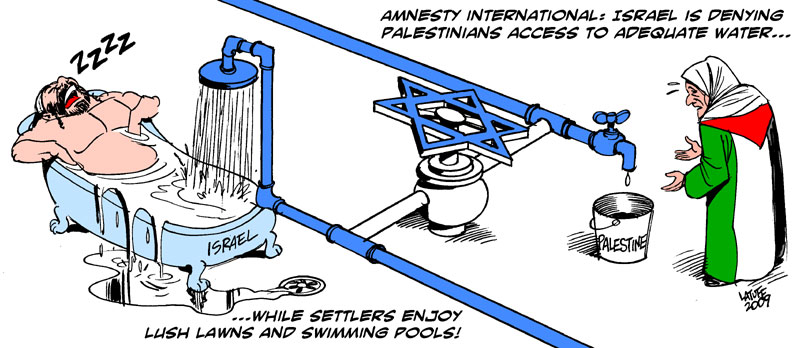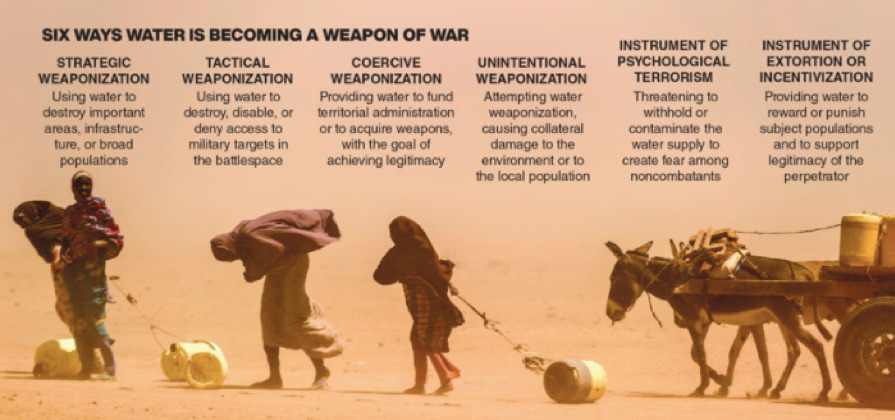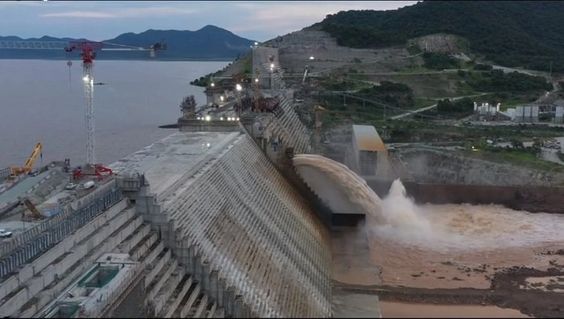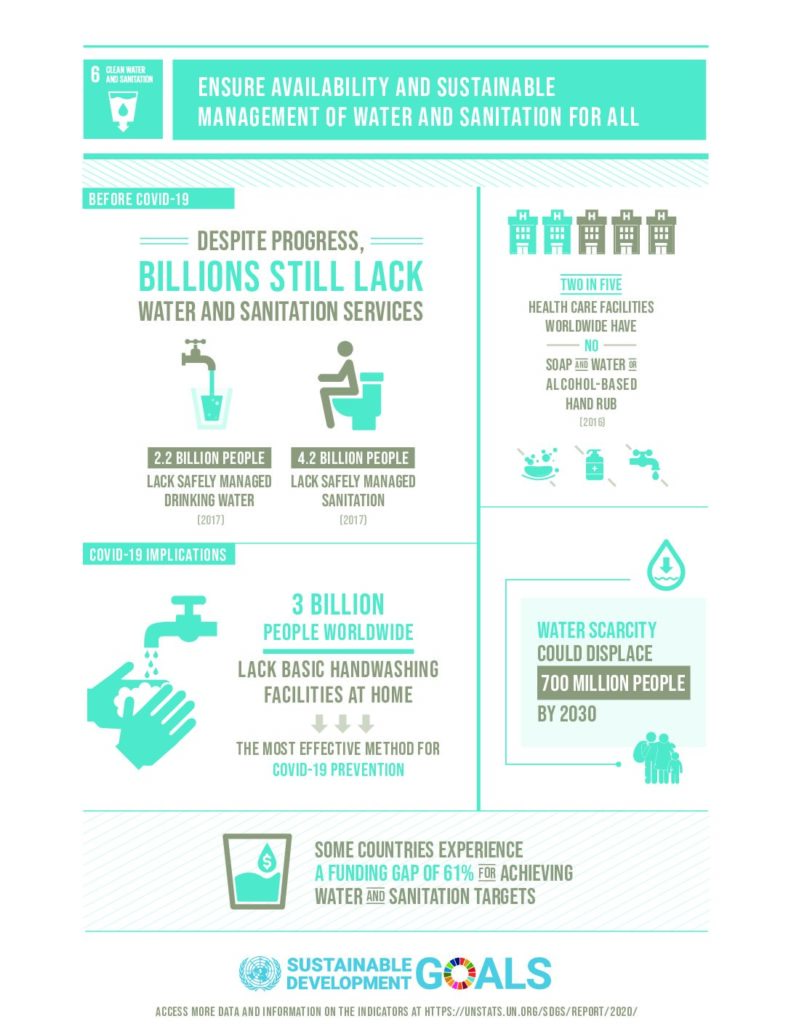

Israelis make videos to tease those in Gaza for not having water or electricity (sick people)
Oxfam report, Water War Crimes, finds that Israel’s cutting of external water supply, systematic destruction of water facilities, and deliberate aid obstruction have reduced the amount of water in Gaza by 94%
Updated December 6. 2024 & December 6. 2023 (originally posted December 6. 2021)

BBC Future: Water crises have been ranked in the top five of the World Economic Forum’s Global Risks by Impact list nearly every year since 2012. Over the 20th Century, global water use grew at more than twice the rate of population increase. Unprecedented levels of dam building and water extraction by nations on great rivers are leaving countries further downstream increasingly thirsty, increasing the risk of conflicts.
INSTITUTE H21: PaulCollier, an expert on the economics of civil war, estimated that close to fifty armed conflicts at the turn of the 21st century had a strong link to water and other resource exploitation, in which either licit or illicit exploitation helped to trigger intensify or sustain violence. The Syria and Iraq region has seen some of the earliest recorded, if not the most frequent, history of water’s use as a weapon. The territory of Syria and Iraq constitute part of the ancient Kingdom of Mesopotamia. The earliest recorded conflict over water in this region was over 4500 years ago when a dispute over access to irrigation water led King Urlama of the city-state of Lagash to cut off the water supply of the neighboring city of Umma.

Today, 19th July, 2021, the GERD reservoir reached overtopping water level. Currently, the incoming flow passes through both bottom outlets and overtopping. This year also we are experiencing extreme rainfall in the Abbay Basin(Blue Nile Basin). As a result, the GERD reservoir pic.twitter.com/MGPeEyC1UF
— Dr Eng Seleshi Bekele (@seleshi_b_a) July 19, 2021
The latest research show water-related violence increasing over time. Population growth and economic development are driving increasing water demand worldwide. Meanwhile, climate change is decreasing water supply and/or making rainfall increasingly erratic in many places.
Charles Iceland, global director for water at the World Resources Institute.
The 1993 Oslo Agreements gave control over basic water resources to the Israelis. The role of the Palestinian side was limited to serving it. The agreements laid down the right of the Israelis to the water of the River Jordan. It also laid down their rights to veto any future talks regarding it. As the Israelis completely control Palestinian water resources, future conflict in the region will be over water resources.
Abur-Rahman Al-Tamimi, Director of the Association of Palestinian Hydrologists 2013

United Nations Global Goals for Sustainable Development
The demand for water has outpaced population growth, and half the world’s population is already experiencing severe water scarcity at least one month a year. Water scarcity is projected to increase with the rise of global temperatures as a result of climate change.
Investments in infrastructure and sanitation facilities, protection and restoration of water-related ecosystems, and hygiene education are among the steps necessary to ensure universal access to safe and affordable drinking water for all by 2030. Improving water-use efficiency is one key to reducing water stress.
Positive progress has been made. Between 2015 and 2022, the proportion of the world’s population with access to safely managed drinking water increased from 69 percent to 73 percent.
Access to water, sanitation, and hygiene is a human right. To get back on track, key strategies include increasing sector-wide investment and capacity-building, promoting innovation and evidence-based action, enhancing cross-sectoral coordination and cooperation among all stakeholders, and adopting a more integrated and holistic approach to water management.
Water is essential to health, poverty reduction, food security, peace and human rights, ecosystems, and education. Nevertheless, countries face growing challenges linked to water scarcity, water pollution, degraded water-related ecosystems, and cooperation over transboundary water basins.
What are the challenges?
In 2022, 2.2 billion people still lacked safely managed drinking water, including 703 million without a basic water service; 3.5 billion people lacked safely managed sanitation, including 1.5 billion without basic sanitation services; and 2 billion lacked a basic handwashing facility, including 653 million with no handwashing facility at all.
By managing our water sustainably, we can also better manage our production of food and energy and contribute to decent work and economic growth. Moreover, we can preserve our water ecosystems and their biodiversity and take action on climate change.
Are water and climate change linked?
Water availability is becoming less predictable in many places. In some regions, droughts are exacerbating water scarcity, negatively impacting people’s health and productivity, and threatening sustainable development and biodiversity worldwide.
Ensuring everyone has access to sustainable water and sanitation services is a critical climate change mitigation strategy for the years ahead.
Without better infrastructure and management, millions of people will continue to die every year from water-related diseases such as malaria and diarrhea, and there will be further losses in biodiversity and ecosystem resilience, undermining prosperity and efforts towards a more sustainable future.
The COVID-19 pandemic has demonstrated the critical importance of sanitation, hygiene, and adequate access to clean water for preventing and containing diseases. Hand hygiene saves lives. According to the World Health Organization, handwashing is one of the most effective actions you can take to reduce the spread of pathogens and prevent infections, including the COVID-19 virus. Yet billions of people still lack safe water sanitation, and funding is inadequate.
COVID-19 response
Availability and access to water, sanitation, and hygiene (WASH) services are fundamental to fighting the virus and preserving the health and well-being of millions. COVID-19 will not be stopped without access to safe water for people living in vulnerability, UN experts said.
The impacts of COVID-19 could be considerably higher on the urban poor living in slums, who don’t have access to clean water. UN-Habitat is working with partners to facilitate access to running water and handwashing in informal settlements.
UNICEF is urgently appealing for funding and support to reach more girls and boys with basic water, sanitation, and hygiene facilities, especially those children who are cut off from safe water because they live in remote areas, or in places where water is untreated or polluted, or because they are without a home, living in a slum or on the street.
In response to the COVID-19 outbreak, the International Organization for Migration (IOM) is adjusting its WASH services to prevent the spread of the disease. This includes continued support to affected, at-risk, low-capacity, and fragile countries to secure WASH services and infection prevention control in health facilities.
Read more about the work in response to COVID-19 by UN-Water members and partners.
Water Action Decade, 2018-2028

40 percent shortfall in freshwater resources by 2030 coupled with a rising world population has the world careening towards a global water crisis. Recognizing the growing challenge of water scarcity the UN General Assembly launched the Water Action Decade on 22 March 2018, to mobilize
action that will help transform how we manage water.
Facts and Figures
- 1 in 4 health care facilities lacks basic water services
- 3 in 10 people lack access to safely managed drinking water services and 6 in 10 people lack access to safely managed sanitation facilities.
- At least 892 million people continue to practice open defecation.
- Women and girls are responsible for water collection in 80 percent of households without access to water on the premises.
- Between 1990 and 2015, the proportion of the global population using an improved drinking water source has increased from 76 percent to 90 percent
- Water scarcity affects more than 40 percent of the global population and is projected to rise. Over 1.7 billion people are currently living in river basins where water use exceeds recharge.
- 2.4 billion people lack access to basic sanitation services, such as toilets or latrines
- More than 80 percent of wastewater resulting from human activities is discharged into rivers or sea without any pollution removal
- Each day, nearly 1,000 children die due to preventable water and sanitation-related diarrheal diseases
- Approximately 70 percent of all water abstracted from rivers, lakes, and aquifers is used for irrigation
- Floods and other water-related disasters account for 70 percent of all deaths related to natural disasters
Goal 6 Targets
6.1 By 2030, achieve universal and equitable access to safe and affordable drinking water for all
6.2 By 2030, achieve access to adequate and equitable sanitation and hygiene for all and end open defecation, paying special attention to the needs of women and girls and those in vulnerable situations
6.3 By 2030, improve water quality by reducing pollution, eliminating dumping and minimizing release of hazardous chemicals and materials, halving the proportion of untreated wastewater, and substantially increasing recycling and safe reuse globally
6.4 By 2030, substantially increase water-use efficiency across all sectors and ensure sustainable withdrawals and supply of freshwater to address water scarcity and substantially reduce the number of people suffering from water scarcity
6.5 By 2030, implement integrated water resources management at all levels, including through transboundary cooperation as appropriate
6.6 By 2020, protect and restore water-related ecosystems, including mountains, forests, wetlands, rivers, aquifers, and lakes
6.A By 2030, expand international cooperation and capacity-building support to developing countries in water- and sanitation-related activities and programs, including water harvesting, desalination, water efficiency, wastewater treatment, recycling, and reuse technologies
6.B Support and strengthen the participation of local communities in improving water and sanitation management
Links
World Water Assessment Programme
UNDP Water and Ocean Governance
UN-HABITAT Water and Sanitation
A Post-2015 Global Goal for Water: Recommendations from UN-Water
Water and Sustainable Development Goals
Information briefs on water and sustainable development
UN-Water Decade Programme on Advocacy and Communication
UN Water and Sanitation Best Practices Platform






Comments are closed.